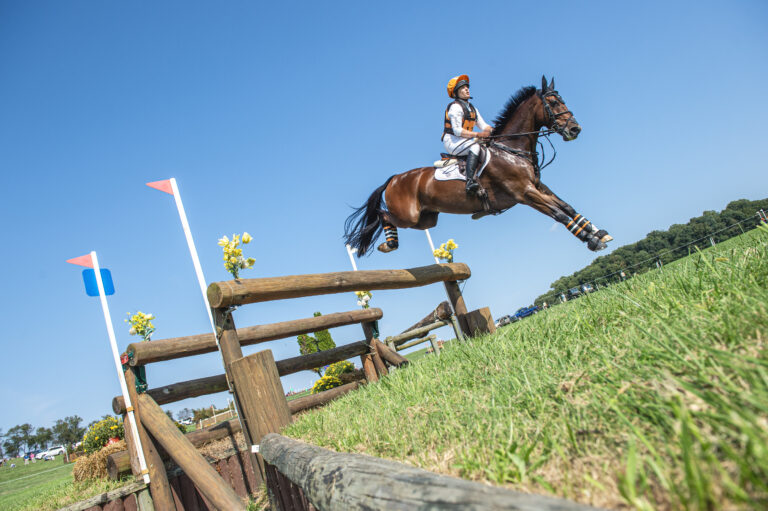.jpg)
The FEI World Equestrian Games overall produced glorious sport with a bonus for the home fans who dominated the stands at the Tryon International Equestrian Center in Mill Spring, North Carolina, in September. The spectators were thrilled to see so many U.S. competitors claim a slew of team medals—gold in show jumping, driving and reining and silver in dressage. There also were several individual U.S. medals, including silver for dressage rider Laura Graves and America’s first three WEG para-dressage medals, along with silver in driving and silver and bronze in reining.
See also: Practical Horseman’s 2018 World Equestrian Games Coverage
Another first was the only tie-breaker in WEG team show-jumping history, pitting the United States against Sweden. The American squad, anchored by McLain Ward, claimed the top prize by a mere 2.06-second margin in the jump-off.
Two days later Ward just missed the individual medals, finishing fourth on Clinta. But as he pointed out, all four team members, including Laura Kraut and rookies Devin Ryan and Adrienne Sternlicht, finished in the top 16 out of 124 starters from 25 countries.
By virtue of their medals, U.S. show jumping and dressage qualified for the 2020 Olympics in Tokyo. Finishing eighth, the eventers didn’t make the cut and will have to try to qualify at next year’s Pan American Games and, if necessary, the Nations Cup. Eventing Performance Director Erik Duvander—who by WEG had been at the helm less than a year—worked on developing a new plan designed to put the United States back on top.
The eventing competition itself went beautifully with its centerpiece cross-country course designed by former U.S. Coach Mark Phillips drawing raves. The route, replete with options, was safe and sane. It marked the first time a world championship was held at a three-star level, rather than a four-star level, and all 16 teams taking part completed, something that hasn’t happened at a world championship since 1994.
In the wake of a disaster involving the endurance race on the first day of the Games (more on that later), some officials wanted to err on the side of caution and reduce the optimum cross-country time from 10 minutes to eight. Along with a group of chefs d’équipe, Phillips fought that. They succeeded, compromising by taking out two fences but leaving in a long run up a hill near the end of the course that had been a hot discussion topic in the months before the Games.
See also: What Went Wrong at WEG?

The Challenges
While WEG offered many shining moments, there also were a lot of not-so-happy memories, many of which involved the weather.
“There’s been some fabulous competitions in fabulous competition arenas, but there’s also been challenges and the weather hasn’t helped. It’s been a difficult WEG,” observed U.S. Equestrian Federation Director of Sport Will Connell, whom American athletes praised, along with his staff, for their efforts to make their experience as smooth as possible.
FEI Veterinary Director Göran Åkerström said the governing body studied the area’s weather for the last three years, prompting them to move the Games from August to September. But still, often oppressive hot and humid conditions prevailed with the threat of Hurricane Florence dominating the headlines.
Even in the two years leading up to the Games, high temperatures and rainfall hampered efforts to execute an ambitious plan to expand TIEC, and Mark Bellissimo, the managing partner of Tryon Equestrian Partners whose ambition for years was to host a WEG, said the booming economy also made it difficult to get some construction materials. As WEG teams began arriving, the facility looked like a construction site—the soundtrack of the early days was the noise of hammers and riveting.
Lack of adequate housing for grooms, along with organizational chaos, didn’t help. On the first day of competition, endurance riders were misdirected, leading to a re-start. Later that day, officials cancelled the championship when the combined temperature and humidity index went too high for horse welfare and part of the newly prepared trail became slippery from a sudden storm. Some angry riders and team officials got into a skirmish after the cancellation and law enforcement was called in to calm things down. The FEI is investigating the situation.
“We got off to such a bad start with endurance that was actually no fault of the organizer, it was just a succession of mistakes. That set a tone … that was very negative,” said Michael Stone, president of the WEG organizing committee.
Meanwhile, throughout the Games, spectators in the main arena grandstand had to sit in the blazing sun amid 90-degree temperatures without anything overhead (except in the upgrade/VIP area) to shield them. Parking and shuttles were a problem early on, as they usually are at a WEG or Olympics. U.S. Dressage Federation President George Williams recalled standing in line for two hours on the first day of dressage before he finally could get on a bus to the venue from the spectator lot.
“We made mistakes,” admitted Bellissimo. “We did the Games because we wanted to save the WEG. From a sport perspective, if the goal was to save the Games [after original 2018 organizers in Bromont, Quebec, bowed out due to financial problems] and produce top sport, I believe we did that.
“What was most important to me is that we stepped up in difficult circumstances and did our best,” he added.
Even their best couldn’t overcome Mother Nature, however. Although Hurricane Florence was a tropical depression by the time it reached the Tryon area five days into the Games, its arrival still caused major problems organizers were powerless to prevent.
Predicted day-long rainstorms and wind gusts resulted in the eventing show-jumping phase being postponed from Sunday to Monday. The dressage Grand Prix Freestyle, also scheduled for Sunday, was cancelled when the FEI and organizers said they could find no way to stage it before the European horses were scheduled to fly home on Monday.
Laura Graves had led the way to silver for U.S. teammates Kasey Perry-Glass, Adrienne Lyle and Steffen Peters and also earned an individual silver in the Special, second to Germany’s Isabell Werth on Bella Rose. Graves, riding her Verdades, was itching for a rematch in the freestyle.
When Graves, who is not known for being emotional, was informed the freestyle had been cancelled, she said, “I burst into tears. It hit me really hard. I’m sure it was disappointing for a lot of people, but it was especially for me, in my home country, to have that opportunity taken away,” she continued, explaining how much she had wanted to share with fans her “very American freestyle” to the song, “Coming to America.”

The Future of WEG
While some of the problems of the Tryon WEG were unique to that venue, many of the difficulties were related to the concept of holding eight world championships at the same time.
“The WEG itself is a massive undertaking and a huge expense to accommodate a large number of athletes and grooms and all the officials,” USEF’s Will Connell said. “The current format is probably unsustainable. It makes for a beautiful menu of sport. But I wonder who can afford to take it on in the future in its current format?”
The FEI is wondering that, too. FEI President Ingmar de Vos promised a re-think at the organization’s annual meeting in November. No one has bid for 2022, so that year could involve individual world championships or pairs of championships that might work well together, such as eventing and driving.
See also: Will There be Another WEG?
The WEG is meant to bring in more people to watch horse sports than would attend stand-alone championships, but at Tryon, weather kept crowds down. The organizers originally planned for WEG to draw 500,000 spectators. But estimates by the end of the Games were that approximately 200,000 attended.
Opinions vary on whether having all the championships together is a help or a hindrance to good sport. Apparently, it depends on which discipline you’re talking about. Jimmy Fairclough, a member of the USA’s gold-medal four-in-hand driving team, said being part of the WEG helps his sport, which also has a stand-alone championship once in every four-year cycle.
“I prefer the WEG,” he commented. “We had a lot of people for our marathon day. If it was just a stand-alone world championship, I don’t think you would have gotten as many people. So many people came up to me and said, `I never knew this existed.’ They were there for jumping or something else but came to watch it because they had time.”
On the other hand, U.S. Show Jumping Coach Robert Ridland said, “The time is right to go back to a show-jumping world championship … WEG is unwieldy.”
Acknowledging that at the WEG show jumping helps promote some of the other disciplines, he’d prefer single or double championships, mentioning that when he ran the FEI World Cup Finals in Las Vegas, jumping and dressage were put together in that format for the first time in 2005 and it worked.
Robert Dover, the U.S. dressage technical advisor, is on the same page as Ridland. “It’s a very different proposition going forward—we’ve seen so many WEGs now lose a huge amount of money,” Dover said.
“I forsee it more probably going into either individual world championships or smaller groups of world championships, where they mesh more easily together. I can imagine endurance will be an individual world championship from now on.”
Jon Garner, Equestrian Canada’s director of sport, observed, “At the end of the day, you’d be hard-pressed to say the sport hasn’t been incredible. I thought when Tryon was awarded it … the competition side would be no problem at all—it would be the other stuff. That’s been proved to be pretty much correct.”
“The number of people you have to entertain, the number of people you have to host, the complications with transport and housing,” said Michael Stone, president of the Tryon 2018 organizing committee. “It not only is a financial burden, but it is also an enormous logistical burden for people who have never done it before.”
Competitors and team officials have a different experience than the average spectator, and many of them praised the WEG, including the stables and arenas. Dover said, “The staff and volunteers were exemplary in every possible way, and the competition itself was the greatest competition in the history of the sport of dressage.”
Garner pointed out that there are pluses to having so many disciplines in one place. “When you get an event like this, you really do get to see what the horse is all about and how this four-legged creature has so many different abilities within their own breeds. As a horse fan, it’s really cool to see.”
“I was quite disappointed about all this negative media, social media,” said Graves. “I had three clients who cancelled their trip based on that media review. To not see our stands filled was very disappointing. I don’t think facility-wise you can compare it to anywhere else. People had temperature-controlled restaurants they could sit down in, the shopping was unbelievable. The venue itself was spectacular as far as accommodations for the horses, the stadium, the footing. It was a great show.”
This article was originally published in the Winter 2018 issue of Practical Horseman.










